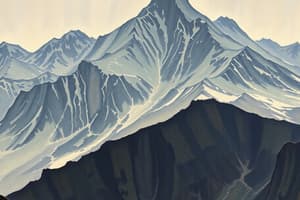Podcast
Questions and Answers
What is the primary characteristic of transform plate boundaries?
What is the primary characteristic of transform plate boundaries?
- Parallel strike-slip faulting (correct)
- Perpendicular fracture zones
- Diverging plates
- Converging plates
What is the orientation of transform fault zones relative to the ridge axis?
What is the orientation of transform fault zones relative to the ridge axis?
- Perpendicular (correct)
- Oblique
- Parallel
- Diagonal
Where do transform plate boundaries occur?
Where do transform plate boundaries occur?
- Only in continental lithosphere
- In both oceanic and continental lithosphere (correct)
- Along convergent plate boundaries
- Only in oceanic lithosphere
What is the cause of deep pull-apart basins in transform plate boundaries?
What is the cause of deep pull-apart basins in transform plate boundaries?
What is the typical location of earthquake activity in transform plate boundaries?
What is the typical location of earthquake activity in transform plate boundaries?
What is the characteristic of the San Andreas Fault system?
What is the characteristic of the San Andreas Fault system?
What is the term for a zone of volcanism that forms a chain of seamounts?
What is the term for a zone of volcanism that forms a chain of seamounts?
What is the relationship between plates and hotspots?
What is the relationship between plates and hotspots?
What is the primary mechanism by which oceanic lithosphere is destroyed and recycled into the asthenosphere?
What is the primary mechanism by which oceanic lithosphere is destroyed and recycled into the asthenosphere?
What is the characteristic of the subducted plate in a subduction zone?
What is the characteristic of the subducted plate in a subduction zone?
What is the term for the area where the process of subduction occurs?
What is the term for the area where the process of subduction occurs?
What is the result of the repetition of the process of sea floor spreading and magnetic polarity reversals?
What is the result of the repetition of the process of sea floor spreading and magnetic polarity reversals?
What is the average thickness of the subducted plate in a subduction zone?
What is the average thickness of the subducted plate in a subduction zone?
What is the term for the plate that is being forced downward into the underlying asthenosphere in a subduction zone?
What is the term for the plate that is being forced downward into the underlying asthenosphere in a subduction zone?
What is the characteristic of the crust produced during a period of normal magnetic polarity?
What is the characteristic of the crust produced during a period of normal magnetic polarity?
What type of plate boundary is characterized by subduction zones?
What type of plate boundary is characterized by subduction zones?
What is the primary source of stress in the subducted lithosphere that generates earthquakes?
What is the primary source of stress in the subducted lithosphere that generates earthquakes?
What is the name of the zone that marks the path of the subducted plate as it descends into the asthenosphere?
What is the name of the zone that marks the path of the subducted plate as it descends into the asthenosphere?
Where did the largest magnitude earthquake in the past century occur?
Where did the largest magnitude earthquake in the past century occur?
What was the consequence of the 2004 Sumatra earthquake?
What was the consequence of the 2004 Sumatra earthquake?
What is the process by which the subducted slab eventually meets its fate?
What is the process by which the subducted slab eventually meets its fate?
What is the term for the region where the subducted plate interacts with the surrounding mantle?
What is the term for the region where the subducted plate interacts with the surrounding mantle?
What is the result of the interaction between the subducted plate and the overlying mantle?
What is the result of the interaction between the subducted plate and the overlying mantle?
What is the term for the layer of the Earth's mantle that the subducted plate descends into?
What is the term for the layer of the Earth's mantle that the subducted plate descends into?
Flashcards are hidden until you start studying
Study Notes
Transform Plate Boundaries
- Transform plate boundaries are intraplate features that are generally oriented perpendicular to the ridge axis.
- They are characterized by active strike-slip fault systems.
- Examples of continental transforms include the San Andreas Fault system in California and the Alpine Fault system in New Zealand.
Fracture Zones
- Fracture zones are intensely faulted, fractured oceanic crust that lies between offset ridge segments.
- Earthquake activity is largely restricted to the transform portion of fracture zones.
Hotspots
- Hotspots occur beneath both oceanic and continental lithosphere.
- Examples include Hawaii and Yellowstone National Park, Wyoming.
- Linear seamount chains, such as the Hawaiian Islands, are surface expressions of hotspots.
Subduction Zones
- Subduction occurs when the leading edge of a denser lithospheric plate is forced downward into the underlying asthenosphere.
- The downgoing plate is called the subducted plate or downgoing slab, and the less dense plate is called the overriding plate.
- The area where this process occurs is a subduction zone.
- Subduction is the major process by which oceanic lithosphere is destroyed and recycled into the asthenosphere.
Oceanic Lithosphere
- The age of oceanic crust increases systematically away from the ridge in opposite directions.
- Crust produced during a period of time characterized by normal magnetic polarity should split in two and spread away from the ridge axis as new crust forms during the subsequent period of reversed magnetic polarity.
- Repetition of this splitting process produces oceanic crust with bands of alternating normal and reversed magnetism whose age increases systematically away from the ridge.
Studying That Suits You
Use AI to generate personalized quizzes and flashcards to suit your learning preferences.




